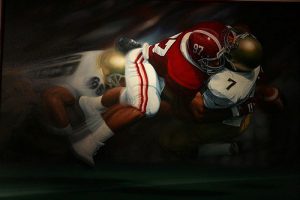Concussions in Kids Near 2 Million Yearly

Concussions in contact sports like football are all too common. It’s important to treat the first concussion and not let it get swept under the rug. (Flickr / Creative Commons / David Smith)
A new study counts nearly 2 million concussions in kids’ sports and play in the U.S. each year. Researchers say that the numbers are imprecise. This is one reason why we need to have a better measure of concussions in this country. The Institute of Medicine recommends a better surveillance system for concussions nationwide.
The estimate for sports and recreation concussions in the U.S. sits between 1.1 million and 1.9 million yearly, according to the study.
Many of these concussions received no treatment at all or went to athletic trainers for treatment. That number ranges from about half a million to 1.2 million who did not seek treatment from a doctor.
The numbers were derived from 2013 hospitalizations, ER visits, doctor office visits, reports to athletic trainers, and previous studies. The study included children under the age of eighteen. It was published in the Journal of Pediatrics Monday.
The number of regular doctor visits, about 300,000, were much more likely than emergency department visits, which was between about 115,000 and about 166,000. There were much fewer hospitalizations. The numbers for that ranged between 2886 and 4936.
Not seeking treatment or thorough examinations for a concussion is risky. Concussions can cause problems in school with concentration and blurred vision. Memory loss, eye pain, and fatigue can also stand in the way of a child being successful in school. It may be hard to foster relationships with long term effects of brain injury. It can also cause mental health problems such as depression, anxiety, and sleep disturbances. However, these conditions may respond to treatment, so there is hope for people with brain injury.
One of the most important reasons for immediate diagnosis of concussion during an athletic event is that without proper protocols, there is no way to prevent second impact syndrome, a condition which can cause severe injury or death. If you don’t catch the first concussion, there is no way to protect the child from the second concussion. The Lystedt case, which galvanized the “no return to play” legislation throughout the country, was a second impact case.
The CDC plans to create a system to track concussions, which would give people a better idea of the extent of the problem nationwide. The theory is that will help determine which activities are most dangerous.
Sometimes it seems like almost all of the money being spent on mild brain injury is being spent on surveillance. I have voiced this concern for a generation. We have been arguing about what constitutes a brain injury for the more than 20 years I have been doing brain injury cases. Then we spend more federal dollars to see how prevalent the particular definition of cerebral trauma is, then we spend another decade deciding if those numbers tells us to do anything different in terms of prevention and treatment. We may sound skeptical about more study, but if you look back at the work that was being done by the CDC 20 years ago, it has an eerily similar quality to what they are doing today.
Do we really not know what activities are dangerous? The head is not meant to be used as a weapon, nor the recipient of the force of other weapons. Cars, and the metal objects and seats within them, can be weapons. The helmet or skull of another athlete can be a weapon. Even the seat belt can be a weapon. While concussion protocols are important, nothing can replace these simple guidelines:
When in Doubt, Sit Them Out. If someone is suspected of having suffered a concussion, monitor their physical, cognitive and emotional function, until you are sure they didn’t suffer a concussion. That means if they are lying on the floor clutching their head, they do not get to go back in the game, even if they seem normal by the time evaluated by a physician at halftime. See Kevin Love’s concussion in the NBA finals.
Don’t Judge Return to Play Issues for at Least 24 Hours. If they are symptomatic for concussion at any point in the next 24 hours, don’t expose them to the weapons of head injury, until a reasonable period of time has lapsed after they were symptomatic.
Amnesia Must be Ruled Out. In determining cognitive deficits, asking questions that will illuminate the question of whether they were amnesic in the period of time after the injury, is important. It is far more important if they don’t remember the ambulance ride than whether they remember the accident. Ask questions about the period of time 20 minutes or more after the event. Not around the moments of the event.
Prepare the Concussed for What is to Come. Warn people about the problems that come with concussion. Don’t return to play doesn’t just means games, it means life stressors, driving, activities where impaired balance may result in another head injury.